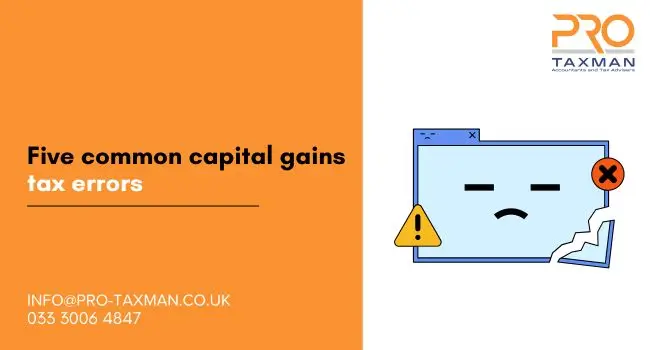HMRC have revealed that every year lots of simple errors are made in tax returns in relation to capital gains tax which result in the taxpayer suffering additional tax, interest and penalties. Here are some common mistakes, and how to avoid them.
1. Using the correct annual exempt amount
When calculating how much capital gains tax you need to pay, it is important to make sure that you use the annual exempt amount for the correct tax year. This is the capital gains tax equivalent of the personal allowance, and is the amount of gains that you are allowed tax-free for a tax year. The annual exempt amount is applied to net gains (gains for the year less losses for the year), and before using losses brought forward from earlier years. Spouses and civil partners each have their own annual exempt amount.
The annual exempt amount is £3,000 for 2024/25, reduced from £6,000 for 2023/24. It is lost if not used in the tax year to which it relates.
2. Disposals of UK residential property
Earlier payment and reporting deadlines apply to gains on UK residential property. UK residents who make a chargeable gain on the disposal of a UK residential property must report the gain to HMRC within 60 days of completion and pay the capital gains due on the gain within the same time frame.
If no capital gains tax is due, for example, on the disposal of property which has been the taxpayer’s only or main residence throughout the period of ownership, the reporting requirements do not apply.
If the taxpayer has also made other gains or losses in the year, the capital gains tax for the year is finalised in the Self Assessment tax return.
3. Private residence relief – final period exemption
Where a property has for some time been the taxpayer’s only or main residence, the gain relating to the final nine months is covered by private residence relief, even if the taxpayer no longer lives in the property. This is increased to the final 36 months where the taxpayer leaves their home to go into care.
Prior to 6 April 2020, the final period exemption was 18 months.
In calculating the amount of private residence relief, it is important that the correct final period exemption is used, and that it is only applied once.
4. Lettings relief
The scope of lettings relief was drastically reduced from 6 April 2020 and now only applies where the taxpayer lets out part of their home and lives in part of it as their main residence and is eligible for private residence relief on part of the gain. It does not apply if the whole house has been let out, even if this was prior to 6 April 2020 when the old lettings relief rules applied. Now lettings relief is only available to live-in landlords. It is equal to the lower of:
- the amount of private residence relief;
- £40,000; and
- the gain relating to the let part.
It is important that lettings relief is only claimed where due and the relief is calculated correctly.
5. Business asset disposal relief
Business asset disposal relief (formerly entrepreneurs’ relief) is subject to a lifetime limit of £1 million. The limit includes amounts of entrepreneurs’ relief – the clock did not restart with the name change.
Taxpayers have also mistaken the limit for an annual limit.
Need professional accounting service or tax advice? Contact us to book a 15-min Free Consultation with us today.
To find out more please follow us on Facebook, Twitter, or LinkedIn. Feel free to contact us on 0333 006 4847 or request a call back by texting 075 6464 7474

